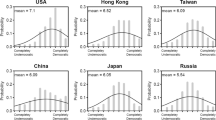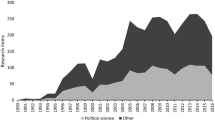Abstract
Many voters seem to appreciate the greater freedom of expression afforded by alternative voting rules; in evaluative voting, for example, longer grading scales and/or negative grades seem desirable in so far as, all other things being equal, they allow greater expressivity. The paper studies to what extent the behavior of voters, and the outcomes of elections, are sensitive to the grading scale employed in evaluative (or “range”) voting. To this end, we use voting data from an experiment conducted in parallel with the 2017 French presidential election, which aimed to scrutinize the negative grade effect and the length effect in grading scales. First, this paper confirms that the introduction of a negative grade disfavors “polarizing” candidates, those whose political discourse provokes divisive debate, but more generally we establish that it disfavors major candidates and favors minor candidates. Second, under non-negative scales, polarizing candidates may be relatively disfavored by longer scales, especially compared with candidates who attract only infrequent media coverage and who are little known among voters. Third, longer scales assign different weights to the votes of otherwise equal voters, depending on their propensity to vote strategically. Overall, we observe that the benefits of the expressivity provided by longer scales or negative grades need to be balanced against the controversial advantage these give to minor candidates, and their tendency to undermine the principle that each vote should count equally in the outcome of the election.






Similar content being viewed by others
Notes
Note that not rating a candidate is systematically considered as giving the lowest grade, 0 or \(-1\) depending on the chosen scale, and the participants were clearly notified about this point.
We can assert with certainty that the voters had assimilated the rule that the default grade was the lowest one: when they do not give a grade, they positively intended to attribute the lowest one and this is a conscious choice. As evidence for this, if we compute the impact of the change of default rule from lowest to median grade, the results of all the candidates arousing rejection attitudes would increase. The score of Marine Le Pen, who arouses strong opinions and no indifference, would increase dramatically.
Note that a similar analysis based on the Strasbourg data under AV vs. EV4 provides similar conclusions as those presented here.
The tests carried out relate to the average frequencies of the grades divided into two segments. Individual comparisons are not possible because no participant used EV4 and EV6 simultaneously.
Note that the same result appears when we consider the different lengths of scales tested in Strasbourg to the same minimum grade, so avoiding other biases: there is significantly less use of the whole extent of the scale from EV3 to EV4 and from EV3neg to EV4neg.
Note that our observation holds for voters’ behavior when testing a new voting rule in an experimental setting. If an evaluative voting rule were to be implemented, these aspects are likely to be covered by the media and political parties, such that we could expect more strategic behavior.
References
Alcantud JCR, Laruelle A (2014) Dis-&approval voting: a characterization. Soc Choice Welfare 43(1):1–10. Previously in: Ikerlanak Discussion Paper IL6312, Departamento de Fundamentos del Análisis Económico I, Basque Country University UPV-EHU, Bilbao, Spain
Aleskerov F, Yakuba V, Yuzbashev D (2007) A threshold aggregation of three-graded rankings. Math Soc Sci 53:106–110
Arrow KJ (1951) Social choice and individual values. Wiley, New York
Baujard A, Igersheim H, Lebon I, Gavrel F, Laslier J-F (2014) Who’s favored by evaluative voting? An experiment conducted during the 2012 French presidential election. Elect Stud 34:131–145
Baujard A, Gavrel F, Igersheim H, Laslier J-F, Lebon I (2018) How voters use grade scales in evaluative voting. Eur J Political Econ 55:14–28
Baujard A, Igersheim H (2007) Expérimentation du vote par note et du vote par approbation pendant les élections présidentielles françaises le 22 avril 2007. Analyses. Rapports et documents du Centre d’Analyse Stratégique.
Blais A, Young R (1999) Why do people vote? an experiment in rationality. Public Choice 99:39–55
Ceron F, Gonzalez S (2019) A characterization of approval voting without the approval balloting assumption. WP GATE Lyon Saint-Etienne 1938
Cox GW (1997) Making votes count: strategic coordination in the world’s electoral system. Cambridge University Press, Cambridge
Darmann A, Grundner J, Klamler C (2017) Election outcomes under different ways to announce preferences: an analysis of the 2015 parliament election in the Austrian federal state of Styria. Public Choice 173(1):201–216
Dhillon A, Mertens J-F (1997) Relative utilitarianism. Econometrica 67(3):471–498
Dittman I, Kubler D, Maug E, Mechtenberg L (2014) Why votes have value: instrumental voting with over confidence and overestimation of others’ errors. Games Econ Behav 84:17–38
Farrell D (2001) Comparing electoral systems. Palgrave, Besingtoke
Feddersen T, Gailmard S, Sandroni A (2009) Moral bias in large elections: theory and experimental evidence. Am Political Sci Rev 103:175–192
Gaertner W, Xu Y (2012) A general scoring rule. Math Soc Sci 63(3):193–196
Gonzalez S, Laruelle A, Solal P (2019) Dilemma with approval and disapproval votes. Soc Choice Welf 53(3):497–517
Grosser J, Schram A (2006) Neighborhood information exchange and voter participation: an experimental study. Am Political Sci Rev 100:235–248
Igersheim H, Baujard A, Lebon I, Laslier J-F, Gravel F (2016) Individual behavior under evaluative voting. A comparison between laboratory and in situ experiment. In: Blais A, Laslier J-F, van der Straeten K (eds) Voting experiments. Springer, Berlin
Lachat R, Laslier J-F, Van der Straeten K (2017) Strategic voting in multi-winner elections with approval balloting: an application to the 2011 regional government election in Zurich, chapter 6. In: Blais A (ed) Strategic voting. Springer, Berlin
Laslier J-F (2019) Voter autrement: le recours à l’évaluation. No. 51 in Collection du Cepremap. Presses de l’ENS, Paris
Laslier J-F, van der Straeten K (2002) Approval voting in the French 2002 presidential election: a live experiment. Exp Econ 11(2008):97–195
Laslier J-F, Blais A, Bol D, Golder SN, Harfst P, Stephenson LB, Van der Straeten K (2015) The euro vote plus experiment. Eur Union Politics 16(4):601–615
Macé A (2018) Voting with evaluations: characterizations of evaluative voting and range voting. J Math Econ 79:10–17
Myerson RB (2002) Comparison of scoring rules in Poisson voting games. J Econ Theory 103:219–251
Narens L (1985) Abstract measurement theory. MIT Press, Cambridge
Núñez M, Laslier J-F (2014) Preference intensity representation: strategic overstating in large elections. Soc Choice Welf 42(42):313–340
Pivato M (2013) Formal utilitarianism and range voting. Math Soc Sci 67:50–56
Schram A, Sonnemans J (1996a) Voter turnout as a participation game: an experimental investigation. Int J Game Theory 25:385–406
Schram A, Sonnemans J (1996b) Why people vote: experimental evidence. J Econ Psychol 17:417–442
Smaoui H, Lepelley D (2013) Le système de note à trois niveaux: étude d’un nouveau mode de scrutin. Revue d’Economie Politique 123(6):827–850
Acknowledgements
This paper has been presented at the INDEPTH conference held at the University of Saint-Etienne in March 2019; the “Individual Preferences and Social Choice” workshop held at the University of Graz in April 2019; the Conference on Economic Design, Budapest, June 2019; the 3rd ILLC Workshop on Collective Decision Making, University of Amsterdam, June 2019; and the “Colloque sur l’histoire et la philosophie des théories économiques, autour du travail de Philippe Mongin”, University of Paris 2, December 2019. We are grateful to Jean-François Laslier, Mostapha Diss, Ulle Endriss, Umberto Grandi, Markus Brill, Hans Peters and two anonymous referees for insightful remarks that have helped to improve the paper. This research has benefited from financial support by the DynaMITE project (ANR13-BSH1-0010), the IDEXLYON at the University of Lyon (project INDEPTH) within the Programme Investissements d’Avenir (ANR-16-IDEX-0005), the CoCoRICo-CoDec Project (ANR-14-CE24-0007), and the University of Strasbourg Foundation. We would also like to thank the whole team of “Voter autrement 2017”, and the public officials who helped us to implement the experiment: see http://www.gate.cnrs.fr/vote/merci.
Author information
Authors and Affiliations
Corresponding author
Additional information
Publisher's Note
Springer Nature remains neutral with regard to jurisdictional claims in published maps and institutional affiliations.
Appendix
Appendix
1.1 Description of the candidates
There were 11 candidates at the 1st round of the French Presidential election in 2017. We here present them in the official order, randomly chosen by the Constitutional Council, and specify their initials, as they are presented in the figures and tables, and results in % in the first round of the Presidential Election.
NDA | Nicolas Dupont-Aignan | Debout la France! (DLF) | 4.70 |
MLP | Marine Le Pen | Front national (FN) | 21.30 |
EM | Emmanuel Macron | En marche! (EM) | 24.01 |
BH | Benoît Hamon | Parti socialiste (PS) | 6.36 |
NA | Nathalie Arthaud | Lutte ouvrière (LO) | 0.64 |
PP | Philippe Poutou | Nouveau parti anticapitaliste (NPA) | 1.09 |
JC | Jacques Cheminade | Solidarité et progrès (S& P) | 0.18 |
JL | Jean Lassalle | Résistons | 1.21 |
JLM | Jean-Luc Mélenchon | La France insoumise (FI) | 19.58 |
FA | François Asselineau | Union populaire républicaine (UPR) | 0.92 |
FF | François Fillon | Les Républicains (LR) | 20.01 |
1.2 Ballot papers used in the protocol
We here display the different ballot papers used in the protocol (see Figs. 7, 8, 9).
1.3 Corrected scores
It must be stressed that both Strasbourg and Hérouville voting stations do not accurately reflect the composition of the French electorate at the national level and, because participation was free and open, participants in the experiment are not representative of their voting station. In order to be able to compare the different experimental results between voting stations, we made a primary adjustment to the rough data in order to correct both representation and selection biases. In a questionnaire added to experimental ballots, participants were asked about their official votes. Each ballot has been weighted by the ratio between the score of the corresponding candidate in the official election and the share of participants who declared to have voted in his/her favor (Tables 7, 8).
Rights and permissions
About this article
Cite this article
Baujard, A., Igersheim, H. & Lebon, I. Some regrettable grading scale effects under different versions of evaluative voting. Soc Choice Welf 56, 803–834 (2021). https://doi.org/10.1007/s00355-020-01300-z
Received:
Accepted:
Published:
Issue Date:
DOI: https://doi.org/10.1007/s00355-020-01300-z







